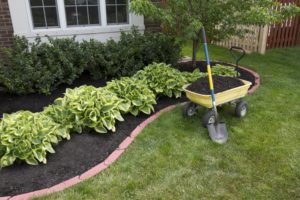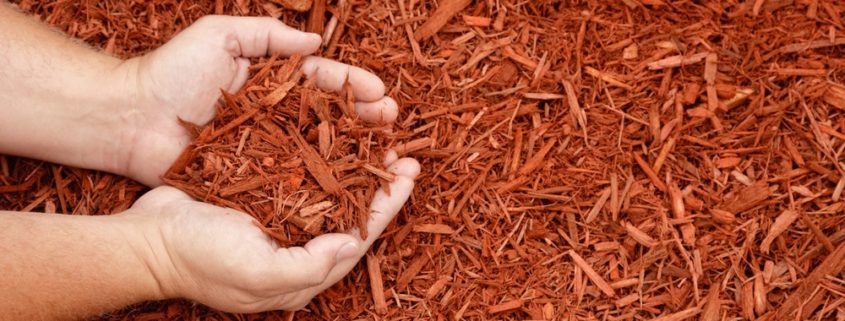What You Need To Know About Mulching
April 2018
Throughout the spring, summer, and fall, the mulch in your garden and landscaping is hard at work for your plants, helping to conserve water, inhibit weed growth, and generally improve the texture of the soil – in addition to just making your yard look good. But did you know your mulch also serves an important purpose in the winter? That layer of mulch creates a kind of insulation that protects the roots of your perennial plants from severe temperature changes that can cause movement in the soil; possibly heaving plant roots out of the ground and exposing them to the harsh winter elements. It serves the same purpose for garden and annual beds, too, protecting the fertility of the soil from the extreme cold.
Now that spring is here again, what should you do with that old mulch that has served you – and your plants – so well? You may be tempted to simply throw another layer on top of the year-old (or more) mulch that’s already there. But that would be a mistake. While the mulch may have served its purpose for the last several months, just leaving it in place and adding fresh mulch on top could do more harm than good. Adding new mulch on top of the existing layer can suppress the natural decomposition process of the old mulch, creating a permanent barrier to plant growth. That’s especially the case if the old mulch has become matted and knitted. Matted mulch will keep rain from fully soaking into the soil below. Shredded hardwood, in particular, is susceptible to matting and knitting together.
So, the first order of business is to check the condition of the old mulch to see if it’s reusable. Grab a handful to get a feel for the consistency. If it has broken down into fine particles to the point where it’s barely distinguishable from the soil, then it’s no longer useful as mulch. If that’s the case in your garden and annual beds, you can till it into the soil and let the organic material serve as a fertilizer along with compost.
For your perennial beds, it’s important to watch the spring weather to get a sense of when the ground is beginning to thaw and the risk has passed for getting any more hard frosts. Even though perennials can sometimes break through the old mulch on their own, more often than not they won’t and damage to the plants can occur. You don’t want to take that chance. That is the time to remove the old mulch. But don’t discard it just yet.
Whether it’s the mulch from your perennial beds or your garden and annual beds, if the mulch has maintained its original look and feel, then you can reuse it. For your annuals, rake the reusable mulch to the side. If necessary, shovel it into a wheelbarrow and dump it onto a large tarp until you’re ready to reapply it. Prepare the soil as you normally would – tilling, spading in compost, etc. – then spread the old mulch over the planting area. Now you can add new mulch as needed. For the reusable mulch, you removed from the perennial bed, hold onto it. Give your flowers a chance to grow high enough that there’s no longer a risk for permanent damage from a heavy layer of mulch. Reapply the old mulch now to inhibit weed growth.
your annuals, rake the reusable mulch to the side. If necessary, shovel it into a wheelbarrow and dump it onto a large tarp until you’re ready to reapply it. Prepare the soil as you normally would – tilling, spading in compost, etc. – then spread the old mulch over the planting area. Now you can add new mulch as needed. For the reusable mulch, you removed from the perennial bed, hold onto it. Give your flowers a chance to grow high enough that there’s no longer a risk for permanent damage from a heavy layer of mulch. Reapply the old mulch now to inhibit weed growth.
So how deep should your mulch be? That really depends on how often you have redressed your beds. If you do it every year, a new layer of 2-3 inches is plenty. You want just enough to cover the old mulch, giving your planting area a fresh, clean look. If, on the other hand it’s been two or three years, you’ll probably need to go a little deeper. That’s because all the mulch in your beds will decompose within three or four years. If that’s the case, consider a depth of 4-5 inches.
While any kind of mulch is effective when used properly, the type and color of mulch is really more about personal preference and how you want your yard to look. For a natural look that will blend nicely into the landscape, shredded hardwoods are a good choice. But if you want to make a statement, try an artificially-colored mulch. Black-dyed mulch is becoming increasingly popular. It creates a nice background for your plants, especially brightly colored flowers and flowering shrubs. Brown-dyed mulches have a more natural look like the shredded hardwoods but tend to maintain their color a little longer.
Red would be the boldest choice. These mulches are a color of red that does not occur in nature, so they are not everyone’s cup of tea. But they do make for a dramatic background for your green shrubs. Many people choose the red-dyed mulch to match the color of brick on their homes or to mimic the look of lava rock. If it’s the lava rock look you want, it might be cheaper, in the long run, to go with the actual rock. It will certainly last longer, but you won’t get the full organic benefit of regular mulch.
Rubber mulches are also an option. Again, they will last longer than natural mulch, but they do have a downside. They tend to attract and retain heat, which is probably not appropriate for anywhere but the coldest climates.
Old mulch or new; natural or dyed; rubber or rock. Give your plants the right mulch this spring and they’ll give you another season of beauty.
Learn more about the cost of yard work in Indianapolis



